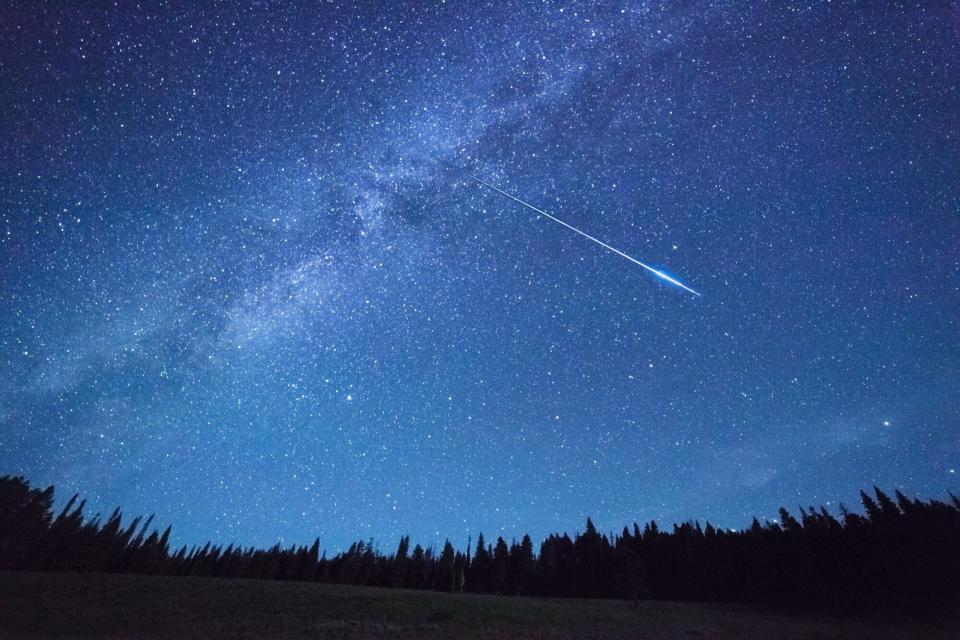7 Glorious Stargazing Events You Don't Want to Miss This Summer

Getty Images
The stars and planets are shining—and putting on a show—just for you all summer long. Throughout the summer of 2021, the night sky will light up with a number of awe-inspiring astrological events you simply must see, especially if you're fascinated by celestial phenomena. From rare blue moons to meteor showers, great conjunctions, and even a lunar eclipse, the upcoming summer season has something for every stargazer. Grab your telescope (or blanket on the grass)—here are few not-to-miss celestial events between May and August to add to your calendar with a reminder to "look up."
May 26: "Blood Moon" and Total Lunar Eclipse
May 26 is a special night for astronomy fans. It not only marks the full Blood Moon, but it also marks the date of a total lunar eclipse.
First, let's explain the full moon. On April 26, the moon is not only full, but it's also relatively close to Earth. According to The Farmer's Almanac, the moon will be just 222,116 miles away from Earth. In fact it'll be so close that those who live near the coasts could see a "dramatically large range of high and low ocean tides around this time." This full moon, The Sky explained, was typically known to early Native American tribes as the Flower Moon because it occurs just as the flowers begin to bloom in spring. This year is a little different, however, and that's because of the lunar eclipse.
On the night of May 26, the moon will pass through the Earth's shadow, which will make the moon appear to turn red—hence why this is also referred to as a Blood Moon. According to The Sky, the eclipse will be visible throughout the Pacific Ocean and parts of eastern Asia, Australia, and western North America.
June 10: "Ring of Fire" Solar Eclipse
If you thought the blood moon was cool, wait until you hear about the "ring of fire." On June 10, those living or visiting Canada, Greenland, or Russia will be lucky enough to look up and see the annular solar eclipse, which occurs when the moon is positioned too far away from Earth to completely cover the sun, explains National Geographic. Because of this, the moon appears to be surrounded by a "ring of fire" as the sun pokes out from behind it. According to National Geographic, "the full eclipse path starts at 9:49 UT over Northern Canada and ends in Russia at 11:33 UT."
Don't worry if you're not directly in its path: A partial eclipse will still be visible in the Northeastern U.S. and Europe. (Just remember to get your solar eclipse glasses early.)
June 21: Summer Solstice
While no flashy show occurs in the night sky on June 21, it's still a significant annual astrological event. On this June date, The Northern Hemisphere celebrates the summer solstice, which marks the longest day of the year and the first day of summer. The summer solstice is often a day filled with celebrations, including a huge sunrise-viewing bash at Stonehenge in England.
July 12: Venus-Mars Conjunction
On July 12, Venus and Mars will come together overhead and appear to kiss in the night sky (very fitting, considering that in Roman and Greek mythology, Venus and Mars—or Aphrodite and Ares in Greek—were known to be lovers). According to National Geographic, the pair of planets will be so close to Earth that they'll be visible through simple backyard telescopes and look like an ultra-bright star to the naked eye. The Venus and Mars "collision" will also be joined by a crescent moon, allowing these two planets to appear as the brightest object overhead.
August 12 and 13: Perseid Meteor Shower Peaks
The Perseid meteor shower is so big it extends into two whole nights. Each August, the sky above the Northern Hemisphere explodes with meteors overhead as the Earth passes through a cloud of debris left over by the comet Swift–Tuttle. These fiery leftovers make up the Perseid meteor shower, which is predicted to be active from July 17 through August 24, with its peak occurring right around August 12. According to National Geographic, this summertime show can produce up to 60 shooting stars an hour, most of them leaving beautiful, visible trains, making these late summer nights the ideal time to make a wish.
August 18: Mars-Mercury Conjunction
Mercury appears to be getting a little jealous of all the attention Venus got from Mars. To make up for it, planet Mars will have its own conjunction with Mercury at sunset on August 18. At that time, the two planets will also appear to touch in the sky. However, this event will be harder to see than others, since it typically occurs close to the setting sun. But you just might catch it if you bring out your telescope and try to find a clear line toward the western horizon.
August 22: Blue Moon
It seems fitting that the summer's epic astrological events will come to a close with a blue moon. According to The Sky, "[T]here are normally only three full moons in each season of the year. But since full moons occur every 29.53 days, occasionally a season will contain four full moons. The extra full moon of the season is known as a blue moon." It's a rare astrological event that only happens once every 2.7 years, so it's a fantastic one to go outside and see. And even though the August 22 moon won't actually look blue, it'll still be a stunning sight to behold—a beautifully infrequent event that happens, quite literally, once in a blue moon.

 Yahoo Finance
Yahoo Finance 